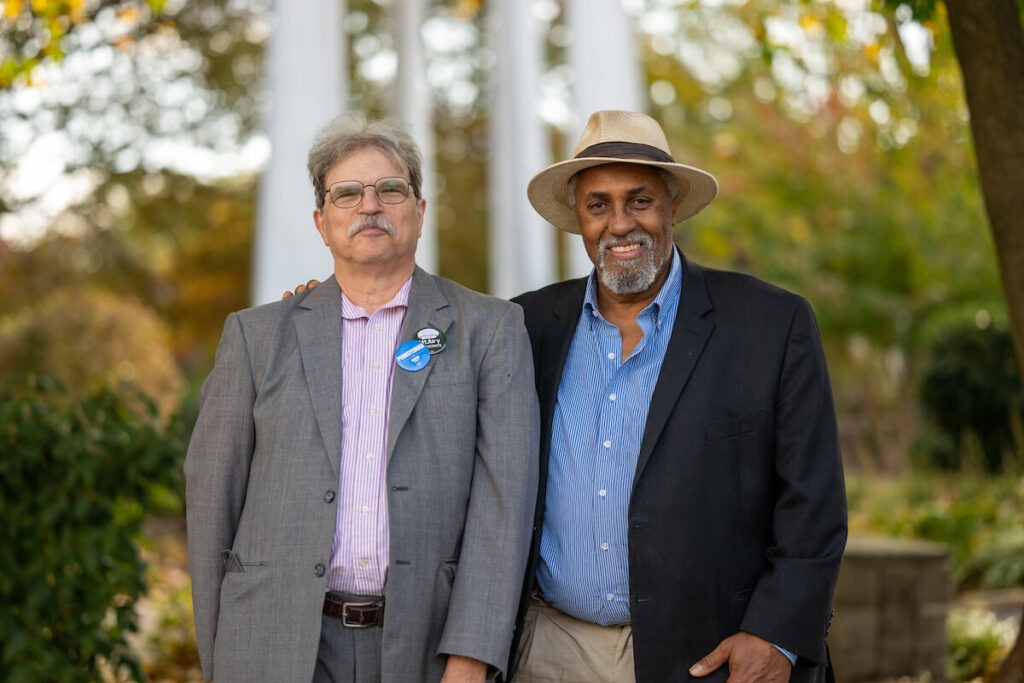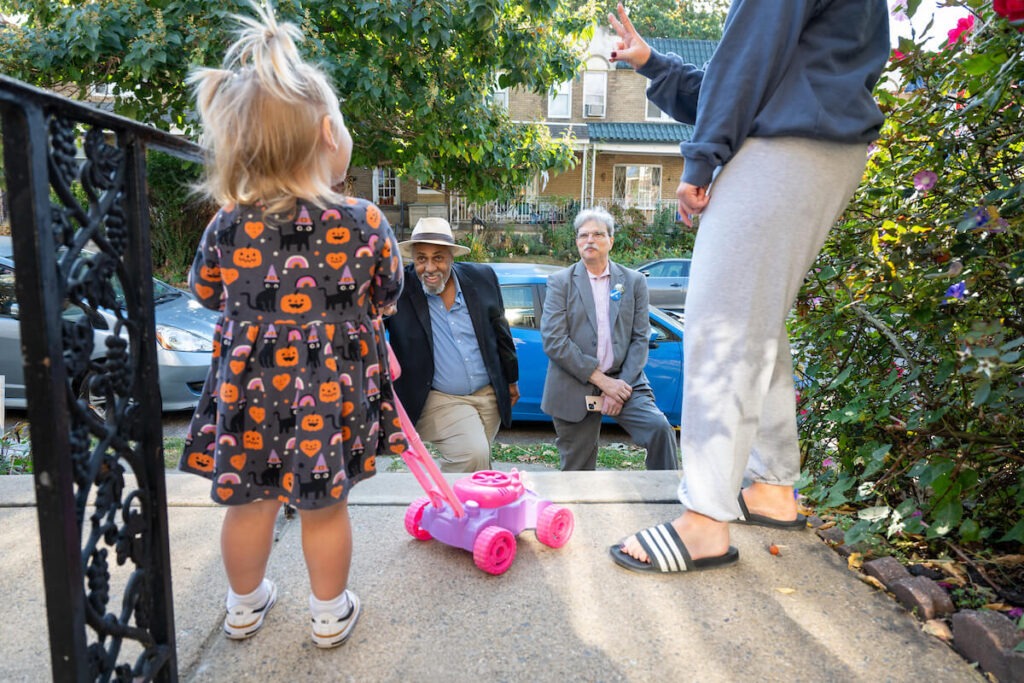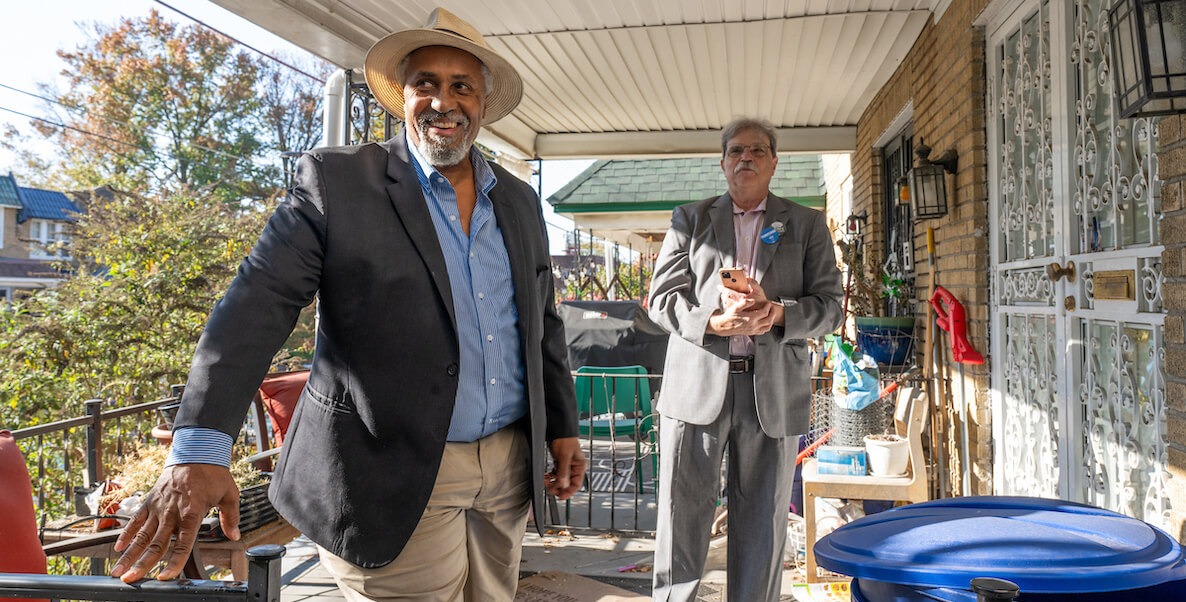For several years before the 2020 election, the elderly residents of Germantown Home needed only to take the elevator downstairs to cast a ballot in the polling center set up in their lobby. It was convenient, and it was busy: Older voters are the most consistent voters, even among the high voter turnout neighborhoods of Northwest Philadelphia.
In 2020, though, because of Covid and the consolidation of polling places, the voting center was moved a few blocks away — too far for many of the mostly African American seniors to walk. They could have voted by mail, as thousands of Pennsylvanians did for the first time that year. But many didn’t want to do that.
“A lot of these folks come from the Jim Crow South, where they couldn’t vote,” says Maurice Sampson, an elected Democratic committee person in the 22nd Ward, 6th Division (22-6), where Germantown Homes is located. “They like to cast their ballots in person.”
So Sampson put out a call for help. He sent messages to the Mount Airy listservs that he uses to answer questions and help with issues election and non-election related. Within 20 minutes, 20 people had volunteered to drive Germantown Home residents to the polls. That year, turnout in that small community of about 750 registered voters was in the neighborhood of 90 percent, Sampson says — well above the 66 percent citywide average.
“That’s the value of having a committed committee person who is connected to the communities and the neighborhoods and communicates with them regularly,” says Sampson, who has since worked to have the polling place returned to Germantown Home, and has since enlisted a resident volunteer who ensures that everyone is registered, educated and casts a ballot. “That’s what we do here.”
For years, Northwest Philly has had among the highest voter turnout in the city. That was the case in 2020 and 2022, and again last year when 50 percent of those in the 22nd Ward cast a ballot for mayor, according to city numbers. The narrative has long been that Northwest Philly — particularly Chestnut Hill — has a lot of voters because it has a lot of the other things that make voting more likely: White, affluent, well-educated residents.

Mount Airy, though, is more diverse than neighboring Chestnut Hill, in all ways, one of the most integrated neighborhoods in Philadelphia. And Sampson, who was the City’s first recycling coordinator under Mayor John Street, has a different take. He credits his divisions’ high turnout to the deep community connections that he and his fellow 22-6 Division Committee person, Michael Kleiner have fostered with year-round outreach, communication and assistance.
“It’s all about relationships,” Sampson says. “By the time we knock on the door at election time, they already know us. We talk about whatever the issues are — potholes, crazy neighbors, the Eagles, Phillies, kids. We also vote. That can be replicated everywhere.”
Will enough Philadelphians turn out to vote?
Turnout is the central story of the 2024 election as we near its end, especially here in America’s most important battleground state. Will enough Philadelphians cast a ballot to sway the election as we did in 2020? What will the small — but crucial — population of still undecided voters do on November 5? What will prove the best method to fill the ballot boxes — pop-up voting centers around the city? Deep canvassing? The barrage of political ads?
The most proven turnout methods according to researchers are the ones that also take the most effort: one-on-one conversations between trusted messengers and potential voters. That’s what Barack Obama realized in 2008 and 2012, when his “ground game” included recruiting local residents to canvas their neighbors. It’s also what Hillary Clinton failed to do as well in 2016, when Democratic turnout in Philadelphia was too low to carry the state.
“It’s all about the neighborhood. Most of voting is not about national elections, it’s about what your local government can do for you. And that’s what we mostly talk about.” — Maurice Sampson, Democratic committee person in the 22nd Ward, 6th Division
But the issue of voter turnout goes beyond presidential years, when at least a majority of registered voters are expected to cast a ballot. (Philly saw 66 percent turnout in 2020, including through mail-in ballots.) In other election years, Philly turnout is appallingly low: In last November’s municipal election, when Philadelphians elected a new mayor and City Council, turnout was just 31 percent citywide. In the senate and governor elections in 2022, it was 47 percent. Meanwhile, according to official City numbers, the 22nd Ward saw 50 percent and 63 percent turnout respectively.
State Rep. Chris Rabb, who represents the area, served as a ward leader and a committee person in the 9th Ward, the highest performing in the city, which straddles both Chestnut Hill and Mount Airy. “Residents here have a greater political literacy,” he says. “They know that voting actually matters.”
That is, in part, because of the neighborhood’s storied history. Mount Airy is one of the longest intentionally racially integrated communities in the country, Rabb notes. When much of the city was experiencing White flight to the suburbs in the 1960s, Mount Airy neighbors of all backgrounds came together and decided to stay together. “Folks here understand that diversity is a strength and a value,” Rabb says. Mount Airy is also home to the 50th Ward, where former State Rep. and City Councilperson John White, Jr., helped desegregate Philadelphia’s Democratic machine through a grassroots movement of its mostly Black residents.
The neighborhood includes several hyperlocal community groups, most of which don’t focus on voting or elections but on the basics of living in a city: zoning issues and cleanups, schools and parks, commercial districts. And its Weavers Way market is the oldest grocery co-op in the city — and one of the longest-running in the country — having started in 1973. “Organizing, and intentionality, is part of the social fabric of the neighborhood,” Rabb says.
Organizing and intentionality are also at the heart of get-out-the-vote efforts in Mount Airy. The most effective, proven way to bring people to the polls is through old-fashioned door knocking. Yet, according to Rabb and the 22-6 committee people, Philadelphia’s Democratic Committee does not encourage canvassing. Mostly, the Ward leaders and committee people are tasked with recruiting poll workers and spreading word about party-endorsed candidates.
But Sampson and Rabb — two people with an established track record of getting high voter turnout — say that’s not good enough. They say potential voters need to feel like they have a stake in the game, that their votes matter because the people they elect are listening to their needs, responding to the neighborhood concerns and helping solve problems.
That means not just showing up every two or four years when a Republican candidate is on the ballot in a federal election — senate or president — and begging for votes.
“If we engage consistently with the people who consistently vote Democratic, we would not be in the situation we are in now, trying to convince people to vote,” Rabb says. “We would have invested where it matters most … What we have in Mount Airy is old-school grassroots organizing: people talking to neighbors, listening to what their priorities are, sharing information about all the things that impact our lives — including how government works for them. It’s that simple.”
“It’s actually a really fun job.”
Sampson was first elected a committee person in 2012; Kleiner was appointed to fill a vacancy in 2016 and elected to the post in 2018 and 2022. They are, still, the only elected committee people in the 22-6. But officially, they no longer hold the title.
In last year’s City Council election, Sampson and Kleiner backed Seth Anderson-Oberman, a Democrat endorsed by the Working Families Party, over the incumbent Democrat Cindy Bass. After Bass, who is also the 22nd Ward Leader, was narrowly re-elected, the city’s Democratic Party promptly ejected them — and 11 others — from their positions. “If you want to play for the Sixers, you shouldn’t be wearing someone else’s jersey,” Bass told Billy Penn at the time.
Still, that hasn’t stopped Sampson and Kleiner from continuing their work. (No one else has been appointed to take over.) Sampson has a long history of civic involvement, which he credits to his mom. She grew up in Houston, next door to Barbara Jordan, who would go on to become the first African American elected to the Texas Senate, the first Black woman elected to the U.S. House of Representatives from the South and the first Black woman to give a Democratic National Convention speech, in 1976.
“What we have in Mount Airy is old-school grassroots organizing: people talking to neighbors, listening to what their priorities are, sharing information about all the things that impact our lives — including how government works for them. It’s that simple.” — State Rep. Chris Rabb
Kleiner, who has lived in the neighborhood for 27 years, says he always needed something to do on Election Day — working on campaigns or at the polls, canvassing for candidates — and figured he may as well make it official by becoming a committee person when there was an opening in 2016. He is the numbers guy of the two, something he credits to a love of sports data and to his father, who for 30 years enjoyed comparing census data to voter turnout.
Kleiner says 22-6 has about 700 Democrats, 22 Republicans and 60 Independents. His list of Democrats differs from the outdated list the City sends to committee people because of the work he and Sampson do to know their constituents. Through door-knocking, following conversations on the listservs, meeting neighbors at events, and other regular check-ins, Kleiner and Sampson track who moves in and out of the neighborhood, who has died, whose names should be added and removed from their lists. And they track exactly where the votes came from, down to the household, so they know whom to target with their outreach for the next election.
That’s how they know that 90 percent of Democrats in their division voted in 2020 — including, Kleiner says, some blocks with 100 percent turnout. That year they started holding weekly Zoom calls to plan and answer questions about election and voting, for community members and anyone in the city. If they heard something they couldn’t answer, Kleiner says, they had City Commissioner Lisa Deeley on standby and called her immediately to weigh in. Some weeks, 20 people attended; other weeks, it was in the neighborhood of 200.
This year’s election-specific work began in February when the committee people hosted a forum to explain to their constituents why they were kicked out of their roles and to lay out what they know about voters in their division. They began door-knocking before the primary election, and have continued this fall, with increasing numbers of volunteers. They also threw an annual fall picnic a couple of weeks ago to get people excited about the election.

Every election, Kleiner sends out a newsletter with information about his choices — including hard-to-find information about judicial candidates. And the pair — the only Black-White team of committee people in their ward — knocks on every door until they’ve reached every voter.
“People are skeptical at first,” Sampson says. “But as soon as you say you’re a neighbor and live on the next block, that changes. It’s all about the neighborhood. Most of voting is not about national elections, it’s about what your local government can do for you. And that’s what we mostly talk about.”
Beyond the election, Kleiner and Sampson monitor four different listservs set up by neighbors on different streets, to help with any issues that come up. Sometimes that means answering election-related questions about the ballot or mechanics of voting. (Nothing overtly political is allowed.) But often, it means helping to connect people with elected officials to advocate for speed bumps, or police officers to deal with porch pirates, identify vendors to help with home repairs, or welcome new residents to the neighborhood.
Most of those on the listservs are Democrats. But outside of election time, Sampson says they don’t distinguish among party membership. “In this neighborhood, Republicans are called ‘neighbors,’” he says. “I’m a committee person for everyone.”
This work is time-consuming; Sampson estimates he spends 40 hours a week on his committee person work during election season, on top of his full time job as Eastern Pennsylvania Director for Clean Water Action. That’s one reason every committee person doesn’t do it. And every neighborhood in the city won’t be able to instantly turn around the kind of deep community engagement that Rabb and the others say is key to Mount Airy’s voter turnout — certainly not in time for next week’s election.
But all of them agree that it is replicable, that what’s needed to get Philadelphians voting is present in every neighborhood of the city, if elected officials, community leaders and party leaders made the effort beyond every May and November to be, simply put, good neighbors.
“We are visible and we are trusted,” Kleiner says. “I can tell by how many of our neighbors take our recommendations for voting, and support our work. The three things you can do to get out the vote are engage; canvass; and get to know your neighbors and neighborhood. It’s actually a really fun job.”
Correction: A previous version of this story misstated the date of Barbara Jordan’s speech to the DNC. It was 1976.
Chestnut Hill Local Editor Carla Robinson contributed to this article, which also appeared in Chestnut Hill Local.

It was produced with the support of the Philadelphia Journalism Collaborative, a coalition of more than 25 local newsrooms doing solutions reporting on things that affect daily life where the problem and symptoms are obvious, but what’s driving them isn’t. Follow at @PHLJournoCollab. Sign up for PJC’s weekly newsletter.
 Every Voice, Every Vote funds Philadelphia media and community organizations to expand access to civic news and information. The coalition is led by The Lenfest Institute for Journalism. Lead support for Every Voice, Every Vote in 2024 and 2025 is provided by the William Penn Foundation with additional funding from The Lenfest Institute for Journalism, Comcast NBC Universal, The John S. and James L. Knight Foundation, Henry L. Kimelman Family Foundation, Judy and Peter Leone, Arctos Foundation, Wyncote Foundation, 25th Century Foundation, and Dolfinger-McMahon Foundation.
Every Voice, Every Vote funds Philadelphia media and community organizations to expand access to civic news and information. The coalition is led by The Lenfest Institute for Journalism. Lead support for Every Voice, Every Vote in 2024 and 2025 is provided by the William Penn Foundation with additional funding from The Lenfest Institute for Journalism, Comcast NBC Universal, The John S. and James L. Knight Foundation, Henry L. Kimelman Family Foundation, Judy and Peter Leone, Arctos Foundation, Wyncote Foundation, 25th Century Foundation, and Dolfinger-McMahon Foundation.![]() MORE ON VOTING FROM THE CITIZEN
MORE ON VOTING FROM THE CITIZEN



